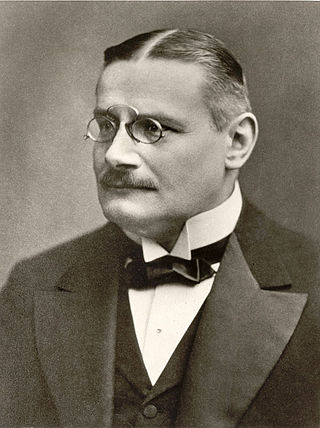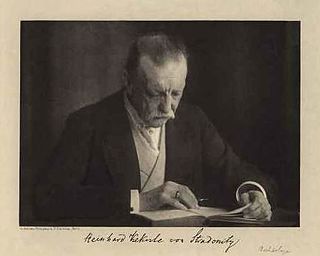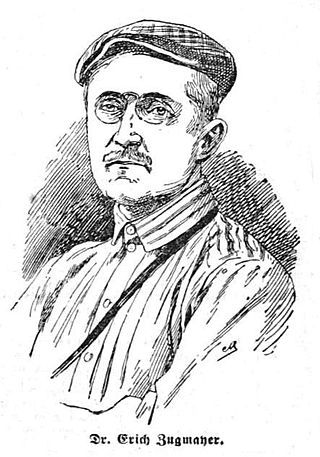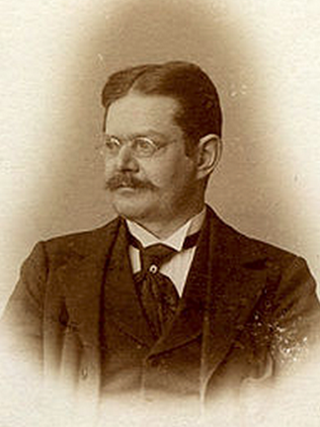
Albert von Le Coq was a Prussian/German brewery owner and wine merchant, who at the age of 40 began to study archaeology.

Karl Hermann Johannes Thiele was a German zoologist specialized in malacology. Thiele was born in Goldap, East Prussia. His Handbuch der systematischen Weichtierkunde is a standard work. From 1904 until his retirement in 1925 he was the curator of the malacological collection at the Museum für Naturkunde in Berlin. Thiele described more than 1.500 new species of molluscs; until today their types are deposited with the Museum of Natural History in Berlin. Especially important are his works on the Mollusca of the First German Antarctica Expedition and of the German Deep Sea Expedition aboard the vessel Valdivia.

Digenea is a class of trematodes in the Platyhelminthes phylum, consisting of parasitic flatworms with a syncytial tegument and, usually, two suckers, one ventral and one oral. Adults commonly live within the digestive tract, but occur throughout the organ systems of all classes of vertebrates. Once thought to be related to the Monogenea, it is now recognised that they are closest to the Aspidogastrea and that the Monogenea are more closely allied with the Cestoda. Around 6,000 species have been described to date.

Reinhard Kekulé von Stradonitz was a German archeologist. He has been called the founder of modern iconology (Langlotz). He served as director of the collection of antique sculpture and vases at the Berlin Museum and also as the director of the antiquarium of the Berlin Museum. Kekulé was the nephew of the organic chemist August Kekulé.

The Gauss expedition of 1901–1903 was the first German expedition to Antarctica. It was led by geologist Erich von Drygalski in the ship Gauss, named after the mathematician and physicist Carl Friedrich Gauss.

Gustav Adolf Graf von Götzen was a German explorer, colonial administrator, and military officer who served as Reichskommissar of German East Africa. He came to Rwanda in 1894 becoming the second European to enter the territory, since Oscar Baumann’s brief expedition in 1892, and later, he became the first European to cross the entire territory of Rwanda.

Plagiorchiida is a large order of trematodes, synonymous to Echinostomida. They belong to the Digenea, a large subclass of flukes. This order contains relatively few significant parasites of humans.

Zoogonidae are a family of trematodes in the order Plagiorchiida.

Echinostomata is a suborder of the parasitic flatworm order Plagiorchiida. The suborder contains numerous species that are parasitic in humans.

Erich Johann Georg Zugmayer was an Austrian zoologist and ichthyologist who worked in the Austrian foreign ministry. He collected extensively in Asia where he went on several expeditions including Western Tibet (1906) and Baluchistan (1911). He described several new species of fishes and several bird taxa were described from his collections.

Gustav Tornier was a German zoologist and herpetologist.
Heinrich Hermann Robert Hartmeyer was a German zoologist.

Opecoelidae is a family of trematodes. It is the largest digenean family with over 90 genera and nearly 900 species, almost solely found in marine and freshwater teleost fishes. It was considered by Bray et al. to belong in the superfamily Opecoeloidea Ozaki, 1925 or the Brachycladioidea Odhner, 1905.
Aegires albus is a species of sea slug, a nudibranch, a marine, opisthobranch gastropod mollusk in the family Aegiridae. Its synonym Anaegires protectus Odhner, 1934 is the type species of the genus Anaegires Odhner, 1934 which was merged with Aegires by Wägele in 1987.

Helicometra is a genus of trematodes in the class Opecoelidae. It is synonymous with AllostenoperaBaeva, 1968, MetahelicometraYamaguti, 1971, and StenoperaManter, 1933. Its type species is H. fasciata(Rudolphi, 1819). They are distinguished by their unique spiral uterus, from which their name is derived.

Echinostomatidae is a family of trematodes in the order Plagiorchiida, first described in 1899.
Notocotylidae is a family of trematodes in the order Plagiorchiida.
Echinochasmidae is a family of trematodes in the order Plagiorchiida.

Lepocreadiidae is a family of trematodes in the order Plagiorchiida.

Nils Johan Teodor Odhner was a Swedish zoologist. Odhner was born in Lund, Sweden. He was the son of the historian and archivist Clas Theodor Odhner and the father of the agronomist Clas-Erik Odhner.














